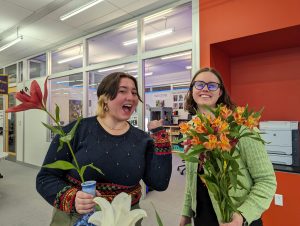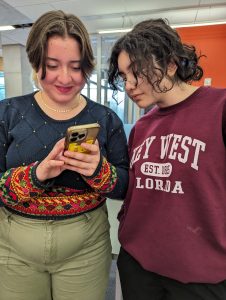
Fig. 1: Isabelle Jiménez and Harper Treschuk outside the Williams College Makerspace located in Sawyer 248
Learning has not been the same since COVID. Just like the vast majority of students around the world, my classes were interrupted by the COVID pandemic back in 2020. After having classes canceled for two weeks, and in an effort to get back on track, my high school decided to go remote and use Google Meet as an alternative to in-person learning. Remote learning did not feel the same — this included using PDF files instead of books for online classes, meeting with peers over video conferencing for group projects, or taking notes on my computer and studying only digital material for exams. I cannot say that I was not learning, because that would not be the best way to describe it, but I can say that something rewired my brain and I have not been able to go back. Due to COVID and other factors, the use of simulations in schools may increasingly supplant hands-on learning and more research needs to be done not only on the implications for content knowledge but also for students’ development of observational skills.

Fig. 2: Sketchfab provides a digital view of the 3D model of a lily, accessible via an iPad interface. This interface allows the children at Pine Cobble School to engage with and explore the object in a virtual environment.
Last week, Williams College students Isabelle Jiménez ‘26 and Harper Treschuk ‘26 visited the Makerspace to start a project for their Psychology class, “PSYC 338: Inquiry, Inventions, and Ideas” taught by Professor Susan L. Engel, Senior Lecturer in Psychology & Senior Faculty Fellow at the Rice Center for Teaching. This class includes an empirical project that challenges students to apply concepts on children’s curiosity and ideas to a developmental psychology study. Isabelle and Harper decided to analyze the ideas of young children following observations with plants, more specifically: flower species. The students plan to compare how two groups of similarly aged children interact with flowers. The first group will interact with real flowers and will be able to touch and play with the plants (Fig. 1), and the second group will interact with 3D models of the plants using electronic devices (iPads) that enable them to rotate and zoom in on the flowers (Fig. 2). By analyzing the interactions of children with real and simulatory flowers, they hope to extend existing research on hands-on and virtual learning to a younger age range. Valeria Lopez ‘26 was the lead Makerspace student worker who assisted them in creating the necessary models which will be covered in this blog post.
I was excited to learn about Isabelle’s and Harper’s project and quickly became involved by assisting them in using Polycam 3D, a mobile photogrammetry app. This app enabled us to quickly create three-dimensional digital models of physical flowers. We opted for photogrammetry as our method of choice due to its versatility—it can model almost anything given enough patience and processing power. Photogrammetry involves capturing a series of photos of an object from various angles, which are then processed by software to create a coherent three-dimensional digital model. To meet our project’s tight deadline, we decided to experiment with smartphone apps like RealityScan and Polycam, which offer a user-friendly approach to 3D object creation. While our standard photogrammetry workflow in the Makerspace provides greater precision, it requires more time and training because it uses equipment such as a DSLR camera, an automated infrared turntable, a lightbox, and Metashape software for post-processing. Despite initial setbacks with RealityScan, we successfully transitioned to Polycam and efficiently generated 3D models. These models serve as educational resources for children, and since precise accuracy wasn’t necessary for this project, using a mobile app proved sufficient. This rapid approach ensures that the 3D models will be ready in time for the educational teach-in Isabelle and Harper are organizing at Pine Cobble School.
Process

Fig. 3: This scene features a daffodil placed atop a turntable, all enclosed within a well-lit box to enhance visibility and detail.
We began our project by utilizing the photography equipment at the Makerspace in Sawyer Library to capture images of flowers in vases. Initially, we were careful to avoid using the provided clear glass vases because translucent and shiny objects are more difficult for the software to render correctly into accurate models. With the guidance of David Keiser-Clark, our Makerspace Program Manager, we selected a vase that provided a stark contrast to both the background and the flowers, ensuring the software could differentiate between them (Fig. 3 & 4).

Fig 4: In the foreground, a phone is mounted on a tripod, positioned to capture the flower’s movement.
Setup
Our setup involved placing the flowers on a turntable inside a lightbox and securing the smartphone, which we used for photography, on a tripod.
Troubleshooting

Fig. 5: Isabelle and Valeria (Makerspace student worker who participated in this project) analyze the 3D models in Polycam.
Our initial approach involved seeking out a well-lit area with natural lighting and placing the plant on a table with a contrasting color. However, we soon realized that the traditional method of keeping the phone stationary while rotating the subject wasn’t optimal for smartphone-designed software. While this approach is commonly used in traditional photogrammetry, our mobile app performed better with movement. Recognizing this, we adjusted our strategy to circle the subject in a 360-degree motion, capturing extensive coverage. This resulted in 150 pictures taken for each flower, totaling 450 pictures. Despite initial setbacks with two different photogrammetry apps, our second attempt with Polycam proved successful, allowing for more efficient and accurate processing of the models (see Fig. 5).
Results

Fig. 6: An alstroemeria flower model, which is one of the final models uploaded to SketchFab. The users will be able to interact with the object by rotating it in a 360 degree manner.
We did not expect to need to do so much troubleshooting! In all we spent 45 minutes loading and testing three different apps, before settling on one that worked successfully. We are extremely happy with the end results. As a final step, I uploaded our three models to SketchFab to ensure that the children could easily access them across different devices (Fig. 6).
Next Steps
- Engage with Isabelle and Harper to gather their general impressions on the kindergarteners and first graders’ interactions with the real and digital 3D models while still maintaining complete confidentiality of the results.
- Take the opportunity to delve deeper into mobile photogrammetry tools and document the process thoroughly. Share this documentation with other makerspace student workers and the wider community to facilitate learning and exploration in this area.
- Collaborate with other departments on similar projects that utilize 3D objects to enhance educational experiences, fostering interdisciplinary partnerships and knowledge exchange.
Postscript (May 10, 2024)
Isabelle and Harper report that their educational teach-in at Pine Cobble School using the 3D flowers was a success:
The students were all able to rotate them and zoom in and out. We noticed that as expected students in the virtual condition reported visual observations while students in the physical condition reported tactile observations as well (but no observations about smell) — interestingly, this didn’t affect the number of observations between the conditions. Students were engaged with the materials although for a couple students we wondered if they became enraptured with the iPad rather than the task of observation itself — they were zooming out so far in order to make a flower disappear. Thanks again for your collaboration and support on this class project. We are interested to hear if the Makerspace decides to partner with the folks at the Cal Poly Humboldt Library in the future.
